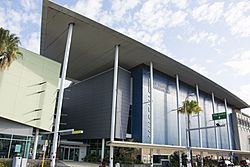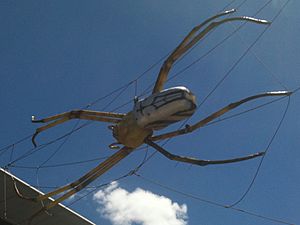Museum of Tropical Queensland facts for kids
 |
|
| Former name | Museum of Tropical Queensland |
|---|---|
| Established | 1987 |
| Location | Townsville, Queensland, Australia |
| Type | Natural history, maritime archaeology |
The Queensland Museum Tropics is a cool place to visit in Townsville, Queensland, Australia. It used to be called the Museum of Tropical Queensland. This museum shows you what North Queensland is like. You can explore galleries about amazing rainforests and coral reefs. It also tells the sad story of HMS Pandora, a ship sent to catch the famous Bounty mutineers.
The museum also looks at life in the tropics, from ancient times to today. It has many different exhibits and displays. These focus on nature, history, and how living things are connected. It is part of the larger Queensland Museum Network.
Contents
History of the Museum
The Queensland Museum Tropics first opened its doors in 1987. It was located along Ross Creek in the middle of Townsville. Back then, it was known as the "Queensland Museum, North Queensland Branch."
In 1990, it officially changed its name to the "Museum of Tropical Queensland." This new name showed that the museum focused on studying and sharing the natural and cultural history of tropical Queensland.
People were very interested in the HMS Pandora ship. This was one of Australia's most important shipwrecks. With lots of help from the Townsville community, a group called the Pandora Foundation, and the government, enough money was raised. This allowed a brand new museum to be built where the old one stood. The new building was made to hold and show the items found from the Pandora shipwreck.
The new museum opened in 2000. It included a life-size model of the front part of the Pandora ship. There was also a special Pandora Gallery. Two more levels of galleries and exhibition spaces were added. The museum also became home to huge collections of corals, sea life, and cultural items. These are now part of Queensland's official State Collection.
Cool Research at the Museum
Scientists at the museum are known around the world for their work. They are especially famous for their studies about the ocean.
Exploring Old Shipwrecks
The museum has a huge collection of items from old shipwrecks. There are over 8,000 items from about 25 shipwrecks found along Queensland's coast and the Great Barrier Reef.
A big part of this collection comes from the famous HMS Pandora shipwreck. The Pandora sank off the coast of north Queensland in 1791. It was trying to capture some of the people involved in the well-known mutiny on the Bounty. The museum also has items from other important shipwrecks like the Foam (1893) and the SS Yongala (1911).
The museum's research on shipwrecks is very broad. They mainly want to understand the items they have and learn more about the ships through these objects.
Dr. Maddy McAllister leads research on shipwrecks that haven't been identified yet. These are ships that have been found, but no one knows their name or what they were. Maddy is looking into ways to find out when and where these ships were built. She does this by studying metal items found on the wrecks. They also look through old records to try and put a name to these mystery ships along the coast.
Aboriginal Cultures and History
Queensland is special because it is home to two main groups of First Nations people. These are the Aboriginal peoples and the Torres Strait Islander peoples. The museum's collections show the rich history and living culture of both groups. The items tell stories about their culture, languages, ceremonies, and tools. The Queensland Museum Network takes care of more than 22,000 Aboriginal items from Queensland. They also have over 28,000 items from outside Queensland and more than 12,000 old photographs.
The Aboriginal cultures collection includes items from many centuries ago. Some of the oldest pieces were made by ancestors long before the 1880s. Newer items have been bought from First Nations artists and communities. These artists create new works using both old and new styles. These collections show how diverse Aboriginal cultures are across the state.
Recently, the museum added works by artists like Niketa Law (Bindal, Wulgurukaba, and Wakka Wakka) and Paul Bong (Yidinji).
The Queensland Museum works closely with First Nations communities. They research and explain the collections they look after. By sharing First Nations voices, languages, and stories, these collections can be properly cared for and shared with everyone.
Current research with First Nations collections looks at how museums can better share these stories. They want to make sure the voices of Traditional Owners and Knowledge holders are heard. Museum staff are also working together to include First Nations knowledge in other research areas. This includes cultural history, nature, and earth science.
Townsville Cultural Centre Collection Project
Since 2005, the Townsville Aboriginal and Torres Strait Islander Cultural Centre (TATSICC) has been a place for sharing. It shows the important history and living culture of Townsville's Aboriginal and Torres Strait Islander peoples.
In 2020, the collection of old and new items from the Cultural Centre was moved. It found a new temporary home at the Museum of Tropical Queensland. The TATSICC asked the museum to look after the collection. It will stay there until a new cultural centre is built in Townsville.
Amazing Corals
The Queensland Museum has one of the biggest and most important collections of reef corals in the world. It has many corals from Queensland's famous Great Barrier Reef. But it also has corals from other parts of the world. By comparing corals from the Great Barrier Reef to those from places like Western Australia or the South Pacific, scientists can learn how special the Great Barrier Reef's corals are.
The museum studies corals to understand their types, how they are related, where they live, and how they change over time. It's surprising, but we still don't fully know how many coral species live on the Great Barrier Reef or exactly where they all are. Knowing how to correctly identify each species is very important. It helps us understand how our changing environment affects corals. This information also helps manage the reefs, from following rules to helping damaged reefs recover.
Discovering Dinosaurs and Fossils
The Queensland Museum has been a key place for studying Australian dinosaurs since the 1920s. This is when the first dinosaur found in Queensland, a long-necked Rhoetosaurus, was dug up and named. Even after a hundred years of study, Queensland's ancient rocks are still revealing their secrets. Many questions still need answers. New technologies are helping scientists learn a lot from fossils. In the past, fossils had to be carefully removed from the rock, which could take months or years. Today, imaging tools like synchrotron x-ray micro-CT scanning let scientists "see through" the rock. They can even see inside the fossils, showing details that would otherwise be hidden.
Understanding the age and type of rock where fossils are found is very important. It helps scientists understand the fossils themselves. Better dating of Queensland's fossil-rich rock formations is helping to place them in a global timeline. For example, recent studies suggest that some Triassic rocks are a bit younger than first thought. This means they are from about the same time as the oldest dinosaur fossils from South America. This raises the exciting chance that some of the world's oldest dinosaurs might one day be found in Queensland!
Images for kids




